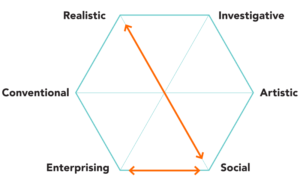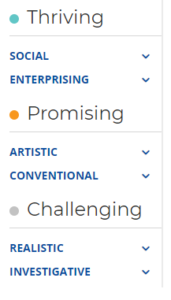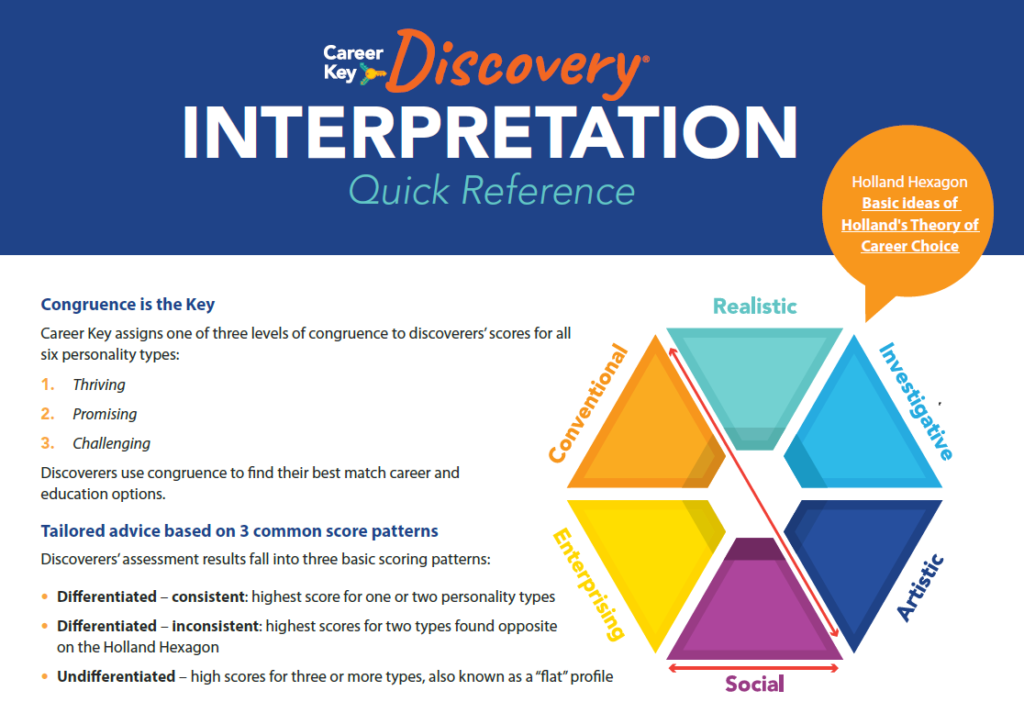Table of Contents
Looking for tips on how to advise discoverers on their assessment results? Go to Advise Discoverers.
Time to Complete
2 minutesOverview
Career Key Discovery (CKD) is based on the science of Career Well-Being. Studies show that “doing what you like to do each day” is vital to happiness and successful achievement. It affects students’ grades, workers’ job satisfaction and achievement, as well as, our health and longevity.
This section describes how CKD helps people make good career and education choices.
Don’t forget to download this CK Discovery Interpretation Quick Reference to help you.
Takeaways
- Understand congruence
- Learn the basics of Holland’s Theory
- Learn how the Holland hexagon is related to career well-being
- Learn how three levels of congruence guide discoverers’ choices
- Become familiar with the three most common scoring patterns and advice
Congruence is the Key Factor
The match between our interests and what we do is called congruence. It is the key factor in determining the state of our happiness and career well-being.
Putting this in more concrete terms, congruence is the degree to which individuals’ Holland personality profile matches, or fits, with their “work” environment. For example, someone with a strong Investigative personality choosing to become a chemist working in a Investigative environment with co-workers who have similar Investigative interests, is a congruent match. The person is likely “doing what you like to do each day”.
The CKD was developed to help people make good choices like this. It was developed through research done at North Carolina State University by Dr. Lawrence Jones. It helps users discover a congruent “career”, one they can look forward to doing. It does this by,
- Assessing the strength of their six RIASEC Holland personality types,
- Directing their attention to work environments congruent with their interests and personality — occupations, majors, or training programs, and
- Providing accurate information and tools to make a good decision.
The CKD is based on the latest scientific research and input from professionals in the field.
The Basics of the Holland Theory
Dr. John Holland’s basic idea is that a person is most likely to be successful and satisfied in a career if their personality is like the personalities of the people working in it. Similarly, a student is more likely to get better grades, stay in their major or program, and graduate on time if their personality is like the students and professors studying and teaching in their program.
In other words, whatever choice someone makes — a career to enter; a course or training program; a college major; a career change, vocation, or retirement focus — they are usually best off choosing one that matches their personality. Major research studies support this idea.
The Holland hexagon and career well-being
Holland’s hexagon shows the relationships between the types,

The distance on the hexagon between each type indicates how close they are psychologically. For example, notice that the type at the greatest distance from the Realistic type is Social. When you read the descriptions for these two types (Realistic and Social), you understand why: their personalities are opposites!
On the other hand, the personality types next to each other on the hexagon are the closest psychologically—like Social and Enterprising.
The hexagon also helps us understand the six RIASEC work environments and how to choose among them,
- People of the same personality type tend to “flock together.” For example, Artistic people like to make friends and work with Artistic people.
- People of the same personality type working together create a work environment that fits their type. For example, Artistic people working together create an environment that rewards artistic thinking and behavior—an Artistic environment.
- The six environments types have the same names as the personality types: Realistic, Investigative, Artistic, Social, Enterprising, and Conventional.
- People who work in an environment similar to their personality type are more likely to be successful and satisfied. Artistic people, for example, are more likely to be successful and satisfied if they choose a job that has an Artistic environment, like a dance teacher in a dancing school—an environment “dominated” by Artistic type people where creative abilities and expression are highly valued.
- Working with people of a similar personality to yours enables you to do many things they do, feel more comfortable, and to be more successful.
- The hexagon serves as a guide to the work environments where we are most likely to “do what you like to do each day”. The Artistic person, for example, would want to avoid a work environment on the opposite side of the hexagon (Conventional).
Using RIASEC Scores to Choose Congruent Environments
Career Key assigns one of three levels of congruence to discoverers’ scores: Thriving, Promising or Challenging.
![]()
Thriving is assigned to the RIASEC type receiving their highest scores. It means that they are most likely to thrive and succeed in work or program environments of this type.
![]()
Promising is assigned to the types that are close (on the hexagon) to their highest scoring personality type. In other words, the person may be comfortable and succeed in work or program environments like these.
![]()
Challenging means that these work or program environments will likely be demanding and uncomfortable for the person. Other environments will better fit their personality.
Note: The numeric scores for the Holland types range from 0 to 33 points. The higher the score, the more the user is like that type. And, the more comfortable they will be in a work or program environment of that type. (A meaningful difference in scoring between types is 5 points).
Exploring and choosing best match careers and programs
During CKD’s Explore section, discoverers use these levels of congruence to find their best match career and education options.

Each career and education program (if shown) is also assigned a level of congruence.


At all times, discoverers easily identify their best matches based on level of congruence.
Three Most Common Scoring Patterns and Advice
Discoverers’ assessment results fall into three basic scoring patterns:
- Differentiated – consistent: highest score for one or two personality types
- Differentiated – inconsistent: highest scores for two types found opposite on the Holland Hexagon
- Undifferentiated – high scores for three or more types, also known as a “flat” profile
Here is an example for Differentiated – consistent, as shown in the Profile section where discoverer can view their bookmarked (saved) careers and programs.

CKD offers different advice to discoverers depending on the pattern of their scores. For more, go to Advise Discoverers.
Next: Careers and Education Programs
Related: Career Key Discovery Manual
